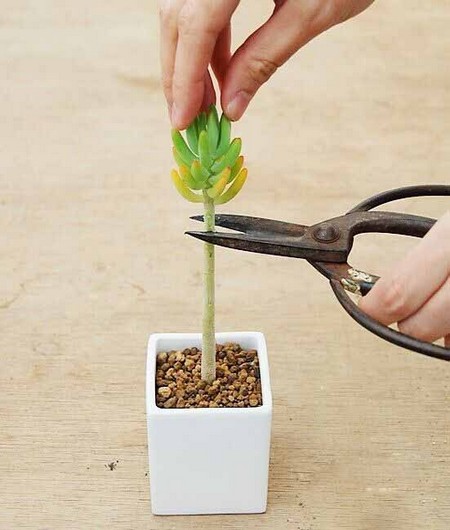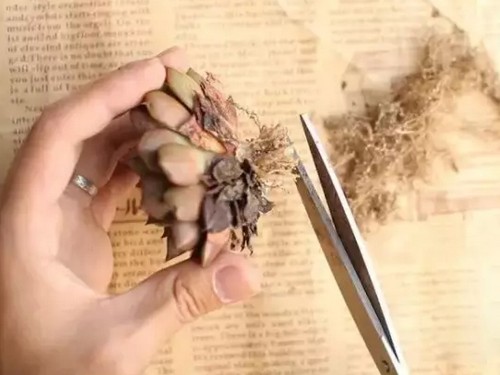Pruning methods of succulent plants cutting propagation of succulent plants
If you find that one of your succulent plants is growing very badly, and there are no new lateral buds, you can start to transform it. In the following picture, either of the two circles can be intercepted, and the excess leaves can be broken off after interception, which can also be used as leaf insertion material. The number of main leaves of branch cuttings decreased, which is more conducive to re-rooting and reproduction. Take the eight thousand generations as an example, it is obvious that the bare stems below have been pulled out and used as leaf insertion materials.

Cut off, the rest of the bare poles do not have to worry about being too ugly, and new buds will emerge slowly. The time is about 10 days, and the time of emergence of new buds varies according to different varieties. And if you are lucky, there will often be 2-3 or even more new buds, which will suddenly become a multi-headed monster (in fact, I think it looks good on a single tree).
Pruning, in most cases, should be used in trees, shrubs or woody herbaceous flowers. General succulent plants have no obvious trunk and no obvious branches. Therefore, plastic pruning is not very important, but timely and reasonable pruning can depress plant shape, promote branches, and make succulent plants grow stronger and more beautiful. at the same time, the pruned branches can also be used for the re-reproduction of succulent plants. Common pruning of succulent plants includes heart picking, branch thinning, strong pruning, residual flower removal, bud picking, root pruning and so on.
1. Pick the heart:
By picking the heart, the succulent plants can be more branched, form more buds and blossom, and make the plant shape more compact and dwarf. Coring is at the top of the stem of a succulent plant and cutting off at the top of the leaf. Suitable for longevity flowers, bear boys, Paek Sul Hui, thunder drum, hanging money and so on.
2. Thinning branches:
The main purpose is to keep the appearance of succulent plant neat and tidy. Generally speaking, emphasis is placed on pruning over-dense overlapping branches, irregular crossed branches, unsuitable overgrown branches and basal sprouting branches, as well as withered branches, disease and insect branches, and so on. It is suitable for plants of the genus Chimonanthus of the family crassulaceae and plants of the genus Linnaeus of the family Euphorbiaceae, and it is better for Pinus koraiensis to be pruned after flowering or defoliation.
3. Strong cutting:
Also known as truncation, the whole plant should be cut off or pruned 10-20 cm from the base of the trunk to promote the germination of new branches at the base or root of the trunk. It is often used for succulent plants whose plants are too high or whose growth is extremely weak. it is suitable for generals, Caiyun Pavilion, African overlord trees, cardinals and so on.
4. Remove the residual flowers:
For succulent plants that do not leave seeds, the residual flowers should be cut off in time to avoid fruiting and consuming more nutrients, which is conducive to the formation of new flower branches. This is too extensive to give an example.
5. Picking buds (including removing buds):
- Prev

Root trimming skills of succulent plants how to trim the roots of succulent plants
In the past, when playing with grass balls, never changing pots, it is naturally impossible to trim roots, because we are well aware of the importance of roots to plants. I'm afraid that if you turn the basin, even if you don't trim the roots, the plants will die. Always think that plants are like fish without water, without soil, why do we have to trim roots?
- Next

Pruning methods of succulent plants how to reproduce succulent plants
If you find that one of your succulent plants is growing very badly, and there are no new lateral buds, you can start to transform it. In the following picture, you can intercept either of the two circles, and after intercepting, you can break off the excess blades and use the
Related
- Wuhan Hospital Iron Tree Blooming Result Was Instantly Frightened by the Gardener Master
- Which variety of camellia is the most fragrant and best? Which one do you like best?
- What is the small blue coat, the breeding methods and matters needing attention of the succulent plant
- Dormancy time and maintenance management of succulent plants during dormancy
- Minas succulent how to raise, Minas succulent plant pictures
- What are the varieties of winter succulent plants
- How to raise succulent plants in twelve rolls? let's take a look at some experience of breeding twelve rolls.
- Attention should be paid to water control for succulent plants during dormant period (winter and summer)
- Watering experience of twelve rolls of succulent plants
- Techniques for fertilizing succulent plants. An article will let you know how to fertilize succulent plants.

